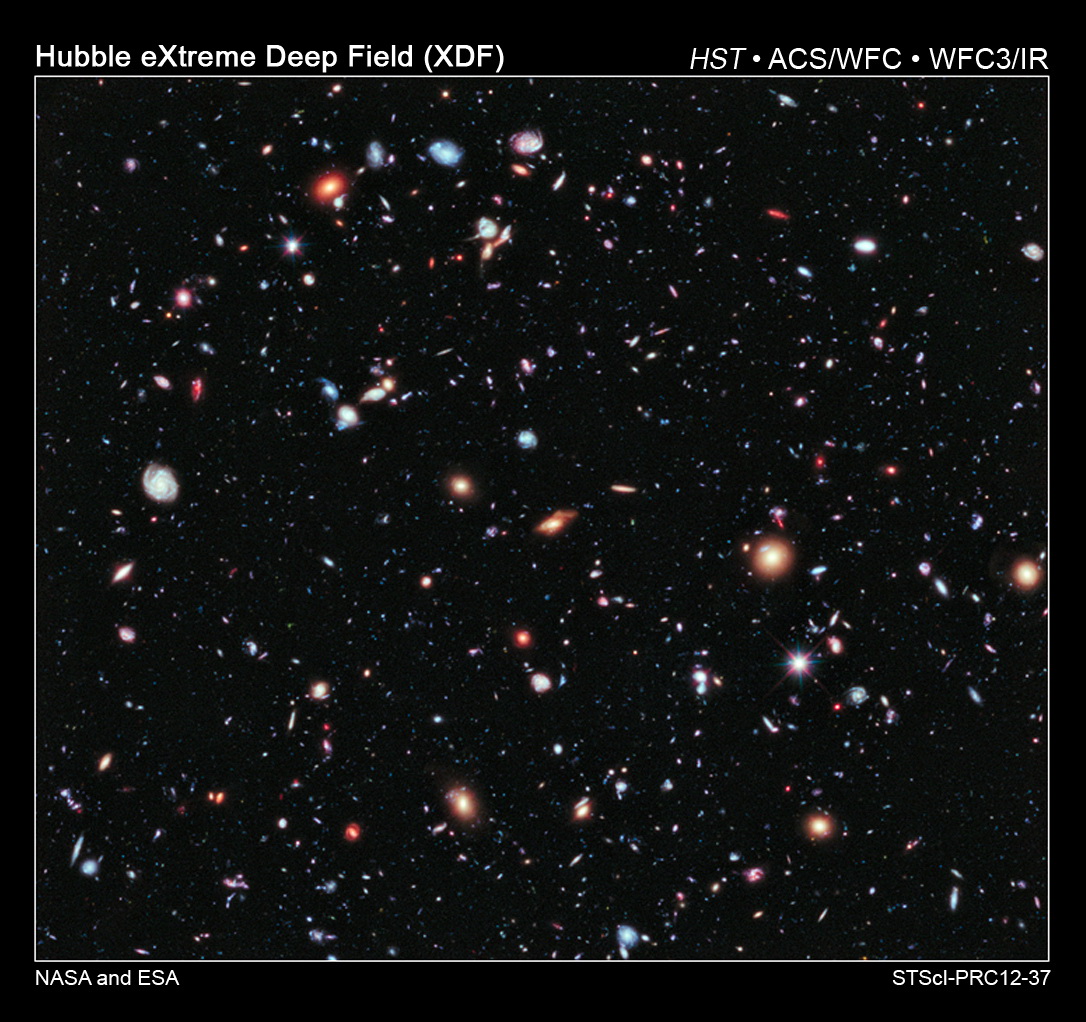 Intelligent Design
Intelligent Design
 Physics, Earth & Space
Physics, Earth & Space
Check This Out: New Hubble “Extreme Deep Field”
Some 5,500 galaxies in a tiny patch of dark sky — for most of human history, who could have imagined such things?
We’ve come a long way since Ptolemy counted 1,022 stars. Get a load of this:

The Hubble Space Telescope’s latest entry in the “Deep Field” category is truly “Extreme” — the deepest look into the universe yet. It represents 22 days’ worth of light collection from a patch of sky smaller than its previous “Ultra Deep Field,” according to the Hubble Site Press Release: “The faintest galaxies are one ten-billionth the brightness of what the human eye can see.”
The BBC News said light collection amounted to 500 hours spread over 10 years. The image, assembled from 2,000 exposures taken by the WFPC3 wide-field infrared camera and ACS, Advanced Camera for Surveys, is abbreviated XDF for “Extreme Deep Field.”
The BBC claimed that the light from some galaxies in the image may date from just 460 million years after the big bang, just a tiny fraction (about 3.3%) of the commonly accepted age of the universe.
But was there a big bang? That’s a question David Berlinski asked in his 1998 essay reprinted in the Discovery Institute Press collection, The Deniable Darwin and Other Essays (2009). Loved and feared alike for his deft dismantling of scientific pretensions, Berlinski asks the questions that consensus scientists overlook. In one paragraph of his rich historical survey, he found the big bangers guilty of circular reasoning:
Cosmologists have routinely assumed that the universe is expanding because they have been persuaded of FL [Friedmann-Lemaitre] cosmology; and they have been persuaded of FL cosmology because they have routinely assumed that the universe is expanding. The pattern would be intellectually convenient if it were intellectually compelling.
If the evidence in favor of big bang cosmology is more suspect than generally imagined, its defects are far stronger than generally realized. (p. 209)
Look at the Extreme Deep Field again. Most people are impressed by the sheer number of galaxies, each with potentially hundreds of billions of stars. They ask, “Why are there so many stars?” Yet perhaps we should be asking the less obvious questions, like Why is the sky dark? Why is the sky lumpy, gathered into dense structures like galaxies and stars with huge voids between? Why are there so few stars?
In his last essay in the book, “The State of the Matter” (2009), Berlinski examined the pillars of the physics establishment: general relativity, quantum mechanics, and the Standard Model of particle physics. These, he explained, were models of “what science should be.” Yet after finding cosmologists delving into non-empirical realms like string theory and the multiverse, providing ultimate answers no better than those of the theists or postmodernists, he keeps asking, like an impatient man tapping his foot, the overlooked questions: “Why are the laws of Nature true, and why do its numerical parameters have the value that they do?” (p. 541).
 Answers to those questions are probed in the documentary, The Privileged Planet from Illustra Media (based on the book of the same name by two Discovery Institute fellows, Guillermo Gonzalez and Jay Richards). Richards asked, Is there a purpose for the universe, and if so, how can we know? The visually-rich survey of cosmic “coincidences,” factors required for life, the elegance and fine-tuning of the laws of physics and the comprehensibility of the universe leads to a compelling conclusion: the universe was designed for discovery.
Answers to those questions are probed in the documentary, The Privileged Planet from Illustra Media (based on the book of the same name by two Discovery Institute fellows, Guillermo Gonzalez and Jay Richards). Richards asked, Is there a purpose for the universe, and if so, how can we know? The visually-rich survey of cosmic “coincidences,” factors required for life, the elegance and fine-tuning of the laws of physics and the comprehensibility of the universe leads to a compelling conclusion: the universe was designed for discovery.
The XDF image reminds us that we live on an ideal platform for viewing the farthest reaches of the universe, allowing us to probe the deepest mysteries of existence with the ultimate tool of discovery: the human mind. Asking what Phillip Johnson calls The Right Questions requires standing outside of current paradigms. Complacency with consensus leads to intellectual laziness. Expand your horizons with these resources from Discovery Institute.
